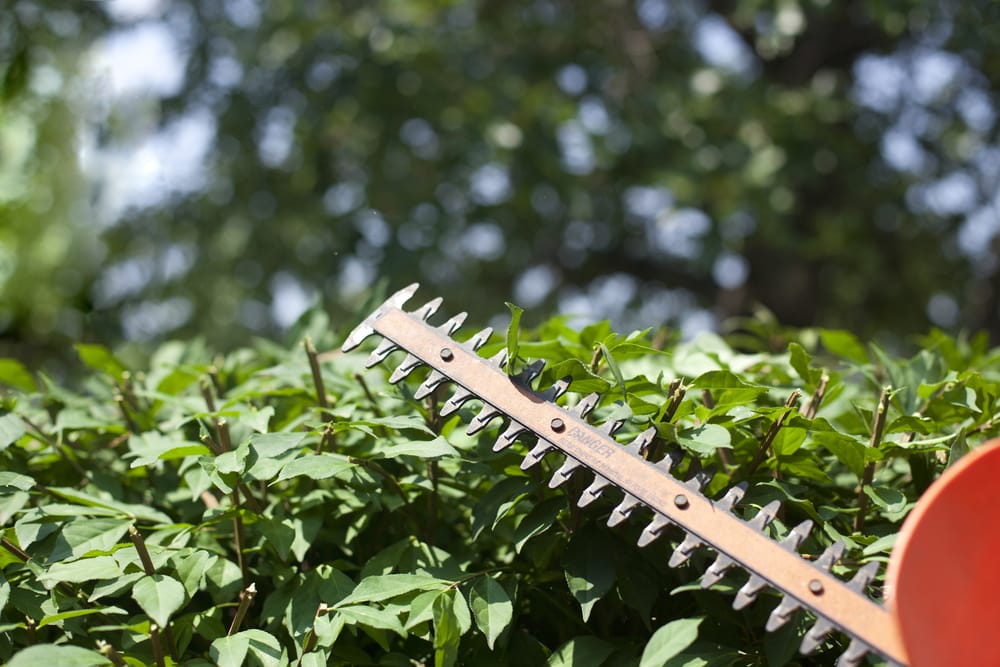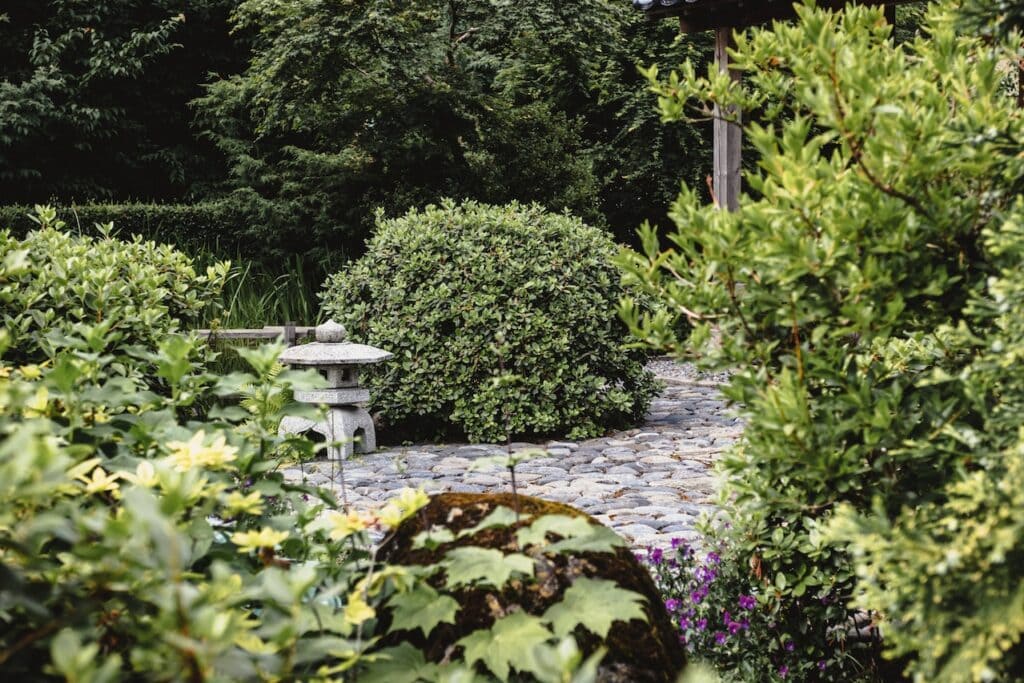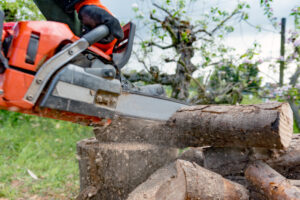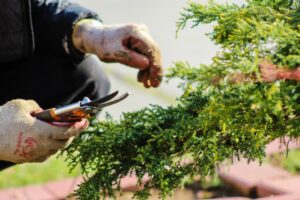It is a fantastic method to improve the sight in your garden by planting hedgerows along the perimeter of your garden walls. However, maintaining and pruning hedgerows on a routine basis is necessary. It may be necessary for you to trim your hedge anywhere from once to three times every year, depending on the variety of hedges you have growing in your garden and the look you want to achieve with it. Even though it may seem like a simple task, improperly cutting a hedge can cause significant damage to the plant and leave it with bare places if the trimmer does not have sufficient training.
Professionals in the field of hedge trimming are familiar with the techniques necessary to trim conifers, which are the most frequent form of hedge that can develop brown and bare spots due to improper trimming. In addition, excessive pruning of conifers can stunt their growth and prevent them from reaching their full potential. Evergreens, such as Bay, Lawson and Leyland Cypress, Box, Holly, Privet, Laurel, and Pyracanther, can be trimmed beginning in the early summer and continuing into the early fall; however, the timing of this activity is subject to change depending on the patterns of the weather.
Plan the outcome
It may seem like stating the obvious, but there are many different kinds of bushes, and the work that you do on them may vary from artistic styling to a simple trim to something else, such as interconnecting them to make a longer shaped like a hedge. The frequency with which you must trim is also determined by the desired outcome.
To protect one's privacy from the prying eyes of neighbours or others passing by on the street, one can train some plants and bushes to grow into a "living fence." In addition to that, it can serve as a windbreak and a barrier for your property.
You might also have a hedge or shrub that has been pruned and shaped to look attractive in a garden. It is up to you to determine how artistic you want to be; nevertheless, a basic round form is very common and can look amazing when done well.
When you have shrubs and hedges that are further along in their growth, it is simpler to determine what you want to do with them. If you already have a hedge serving as a barrier, all that is required to maintain it looking wonderful is to prune it twice per year.
Using the appropriate equipment
When trimming hedgerows, one should always use shears or hedge trimmers with the sharpest blades possible. Because pruning is time-consuming, you should leave it to us. We will gladly offer you an estimate as well as the most appropriate amount of time necessary to finish the task. During our hedge trimming service, we will tackle hedges of any form or size, bringing them into tidiness while also providing them with the same careful attention that we provide to your grass. Your neighbours will be impressed with the appearance of your garden once the hedgerows have been trimmed, and they will want to know what you do to keep the plants in such good health.
The shape of your hedge is fundamental.
The form that your hedge takes is one of the most essential factors in determining the overall health of your hedge. In formal gardens, you could come across a topiary hedge that has been pruned into a perfect square shape. Nevertheless, the reality is that most gardens do not have the open space to allow such a clean square end with the basic levels of sunshine for a healthy hedge of this kind.
Cambering the curve of your hedge so that it is slightly narrower at the top than at the bottom is something you need to do, particularly on larger hedges.
Hedge trimming shapes
The following is a guide on how to trim a hedge. Beginning at the bottom of the hedge, cut your way up to the top of the hedge by working your way progressively upward. When pushing the cutting bar along the hedge, make sure to take it nice and easy and at a steady pace.
Do not attempt to push the blades to cut; rather, slide them and allow them to perform their function. If you cut too deeply into the hedge on your initial pass, you risk removing or breaking more branches than you would otherwise. Instead, make numerous shallow passes to remove a few inches at a time by snipping the excess.
You will need the following kinds of tools to give your hedge the desired regular shape:
- Hedge trimmer
- String
- Wooden stakes
And whether you want your hedges to have an irregular form, a round shape, or a spiral shape, the following tools can assist you in achieving those shapes:
- Wire meshing
- Hand shears
Round
Now, let's focus on the many strategies and recommendations for hedge trimming that will result in rounded-shaped hedges.
If you wish to go around a hedge, the greatest place to begin is around 8 centimetres (three inches) from the peak. To create a smooth curve, you should rely on your instinct, impulse, and eye. To ensure an even appearance, you will need to perform this motion around the hedge numerous times. If necessary, make the necessary modifications.
Without using your eyes as a guide, it is challenging to create this shape. Unless, of course, you want to utilise wire mesh as a form of guiding. It is recommended that before the creation of any feature, practice be done on a hedge that is not as noticeable.
Spiral
It may appear to be difficult to follow the procedures for spiralling hedge-trimming shapes, but all you need is a sharp eye and some experience to get the hang of it. When you are shaping it into a cone, you should make the bottom of the hedge wider than the rest of it. Find the point of growth that is most vital to your hedge and begin at the top, working your way down to the base to form the cone shape.
You can use a piece of string to mark the placement of the spiral, which will serve as a guide for your shears as you make your way around the plant. To make the shape of a spiral, begin at the bottom of the hedge and work your way up, cutting the leaves at an angle just below the string as you go. Increasing the angle progressively as you proceed will result in a more distinct spiral.
Box
The most effective types of formal hedges are hedge boxes that encourage dense growth and have small leaves. Not only do they have a stunning appearance, but also they are incredibly simple to mould and keep in good condition due to their natural state. However, even though this is the design that can be created with the least amount of effort, creating informal hedges with a lot of leaves would be rather difficult.
Triangle
When trimming a plant into a triangular form, the widest part of the plant should always be at the base of the hedge. To give your hedge the desired slopes, you must first plan out the actual shape you desire and then adhere to that design. When you are finished with the mapping, check to see that all areas of your hedge will have adequate exposure to sunshine. This is extremely important since dark areas that are not exposed to sunlight have the potential to deteriorate and turn brown.

Hedge trimming techniques
Since you now have the necessary tools, you may move forward with the hedge-cutting endeavour you've been planning.
Hedge trimming can be done in a variety of ways, but the method that you use will be unique to the shrubs that make up your hedge as well as the development stage that it has reached. Again, the Royal Horticultural Society (RHS) offers highly extensive recommendations on how to prune various kinds of shrubs based on their composition and the species to which they belong.
Cutting a hedge back - maintenance hedge trimming
Hedge pruning of this kind is necessary for hedges that are already well-established, and it should be performed somewhere in the range of two to three times per year.
Because you will already have a well-formed hedge shape, to begin with, the majority of the work involved in keeping the hedge will consist of trimming the hedge back so that it decreases in size and moving upward along the hedge. Because hedges naturally develop into the shape of a V over the course of time, you will need to do this.
This occurs because the section of the hedge that is at the top receives more daylight than the part at the bottom; consequently, the part of the hedge that is at the top develops and widens more quickly. This, in turn, generates shade, which prevents sunlight from reaching the bottom of the hedge, which ultimately results in the bottom of the hedge generating less foliage and becoming narrower.
To avoid this, the maintenance trimming needs you to do the following:
- Reduce the height of the hedge so that its bottom is wider than its top.
- Your hedge should be trimmed at an angle such that the top of the hedge begins more narrowly than the bottom of the hedge. This ensures that the lower foliage receives the maximum amount of sunlight and, over time, contributes to a more equal hedge.
- As you progress up the hedge, you should always begin shearing from the bottom up, and you should adjust the angle at which you cut to create a thinner top. Check your work at regular intervals between trims to ensure accuracy.
- It is important not to prune the tree's main branches because they form its framework.
- Never take more than 25 per cent of the tree's limbs from the outside, and never touch the larger, more substantial branches.
Formative hedge trimming
Formative pruning of a hedge is a little more involved than routine maintenance trimming, and it also requires more forethought. You must be prepared because a significant portion of this pruning work must be carried out during specific times of the year.
When you plant the hedge, you will often need to perform formative hedge trimming beginning at the time of plantation and continuing up until the hedge is approximately two or three years old. It is essential to do this to guarantee that the hedge will develop into the proper shape. After that point, the only thing that will be required of the hedge is maintenance.
Long-reach Hedge Trimming
If you are going to be trimming long parts of a hedge, you should look for a hedge trimmer that has a long blade since it will help you shape the hedge correctly while also allowing you to do the task more quickly.
The use of a telescopic shaft to cut the peak of hedges and other difficult-to-reach locations not only improves the overall beauty of hedges but also alleviates the back strain that is associated with reaching the top of hedges.
How to trim a hedge camber
If you don't give your hedge a "batter," then the lower portion of the hedge will eventually receive less light and will have difficulty thriving as a result. You will end up with a lot of thick growth at the top of your hedge, but the lower portion of the hedge will be thin and unattractive. It also has a supplementary benefit in the sense that a camber or battered or cambered-topped hedge is less likely to be adversely affected by snowfall than a square-topped hedge.
There is a good probability that the weight of the snow will break off and crush the margins of the branches along your hedge if it continues to sit and build up on the highest point of the hedge.
A batter or camber is a slope that lets the snow slide off more easily before accumulating.
Renovating an old, out-of-shape hedge
You may have recently relocated when you discovered that your previous home had a hedge that was either very old or completely out of control. The very first idea that sprang to mind was to throw it away and begin afresh. If you have the patience necessary, though, you can give an aging hedge a makeover in a pretty short amount of time. In addition to this, it is a lot less expensive and involves a lot less labour than taking down the hedges and beginning over.
You need to trim the hedge down to a height of about 2 feet to stimulate new growth at the base of the hedge and the new 'top' of the hedge. This may sound like a cruel thing to do, but it is necessary. This is by far the most effective method for giving an aging hedge a new lease on life.
First, using a chainsaw, chop through the current hedge in pieces until you reach the mark that indicates 2 feet. After that, all that needs to be done is wait to see the new growth emerge, then prune it twice a year as if it were a whole new hedge entirely.
After only three weeks, the newly replanted privet and hawthorn hedge in this area has already shown signs of new growth. Believe me when I say that I've tried this on some truly terrible hedges and that after some patience and tender loving care, they all came back to life again.
When is the best time to cut hedges?
When you should prune or cut, your hedge depends on whether they're evergreen or deciduous, how quickly they grow, and what level of "neatness" you desire from them. You should trim your evergreen and deciduous hedges two times a year, once in the early spring and again in the later summer.
Hedge plants that are evergreen retain their leaves throughout the entire year.
Hedge plants that are deciduous shed all of their leaves or some of them over the winter.
When it comes to some evergreens with larger leaves, I often just trim them once in the middle of August. This is especially true for younger hedges. If you trim your hedgerow at least twice a year, you will almost certainly achieve your goal of having a neat and orderly hedgerow in your yard.
You should make it a point to avoid trimming hedges during the times of the year when birds may be breeding in them. This is a good rule of thumb to follow. This can take place at any point between February and August, which may sound quite problematic to a gardener who is short on time.
This time frame varies depending on where you reside, the number of birds in your area, and whether or not your neighbourhood has dense hedgerows. There is a greater possibility of birds nesting in other areas. They will typically steer clear of loud residential neighbourhoods if there is a more peaceful hedgerow in the vicinity.
You should always pull back sections of the hedge before you clip it, typically at the beginning of March and then again in August, to check for nests. Hedge trimming should occur before or after birds have nested in it. I also have a general idea of where the nests of other species, such as blackbirds and other birds, are located, which allows me to time my pruning around those locations. After determining whether or not it is in use, I remove myself from that portion of the hedge.
You should really avoid doing any trimming in the months of April or May because that is when birds are most likely to be nesting there. It is best to check, and it is better to try to be as polite to our flying friends as possible. There are occasions when you may not have a choice, particularly when removing a hedge for landscaping purposes, but it is best to check anyway. Birdhouses and other nesting choices provide birds with the opportunity to nest in a variety of locales.

A step-by-step guide to formative hedge trimming
- After planting your hedge, you should prune the branches to be of the appropriate height and shape. It is important that the top of the hedge not be chopped.
- Retaining the base of the hedge such that it is slightly larger than the top of the hedge requires regular trimming. This involves generally levelling out the outside layers of your hedge while maintaining the base. Because of this, each and every branch will be able to take advantage of the sun.
- When you perform your initial summer pruning, you should only make mild cuts to the side branches; this will stimulate bushing out, contributing to the overall volume of your hedge.
- After the first year, in the late winter or early spring, you should prune your hedge so that it has half as much growth as it did before.
- During the second summer after the hedge has been planted, perform routine maintenance on the side branches to promote growth that is tapered towards the top.
- You can ultimately trim the peak of the hedge, also referred to as the "leading shoot," during the second fall of the hedge's growth to achieve the ideal height of the hedge.
The best hedge-trimming tips and techniques
Trim between three and four times per year.
The appropriate cutting period comes first on our list of advice for ideas and approaches to hedge trimming. Formal hedges must be meticulously trimmed 3 - 4 times a year to keep their nice, groomed appearance. On the other hand, in contrast to formal hedges, informal hedges can have their growth shaped into a more natural form with only a once or twice-yearly pruning.
When spring first begins, you shouldn't cut the hedges.
When it comes to the topic of cutting hedges, we cover the many methods and strategies for hedge trimming; nevertheless, it is also essential to discuss the mistakes that should be avoided. We are not recommended to perform any pruning in the early spring. You ought to steer clear of doing it for a few different reasons.
During the winter and early spring months, the cold can be detrimental to sprouts that have not yet reached their full potential. When hedge trimming occurs when temperatures are below zero, the newly pruned growth is at an increased risk of suffering irreparable damage from the frost.
In addition, the months of March through August constitute the bulk of the nesting season for birds. It is extremely advised that you refrain from pruning hedges with excessive growth during that time period. Only maintenance cuts should be made. In addition, before beginning with the cutting, always check the area completely for any active nests.
Trim sides at an angle.
If you cut the sides of the hedge at an angle along the sides, the outcome will be a wider crown at the bottom and a narrower one at the top of the hedge. This is a good form for the hedge because it does not prevent it from receiving sunlight. The lower branches and roots of the hedge will, in point of fact, be exposed to an increased amount of natural light, which will contribute to the hedge's appearance of being lush, vibrant, and green.
Cutting at an angle is an excellent way to achieve stylish shapes when trimming hedges, as it helps to define the sides. However, this is not the case with conventionally designed square or rectangle-shaped formal hedges with level tops.
We recommended that you keep the cutting bar of the hedge trimmer totally level while progressively guiding it left to right, then right to the left, to cut the hedge flat at the top. This will allow you to get a clean cut. Keep in mind that if you use a hedge trimmer, you can cut in any direction of the hedge.
Clear away the clutter, and put the finishing touches on the shape of the hedge.
After you have completed the initial few passes with the hedge trimmer, use your hands or a leaf rake to remove the severed branches and leaves. Take a step back and look at the hedge to see whether or not it requires any further trimming. If required, further trim the hedge until it has the desired final shape.
Extra hint: For trimming particularly tall hedges, you should look for hedge trimmers with increased reach capabilities. The trimmer is attached to a long shaft that is also adjustable through a shaft that is adjustable. Standing on a ladder is replaced with an activity that is simpler and safer thanks to this tool: pruning tall branches.
9 Tips for Using Hedge Trimmers
However, if you have any issues regarding the use of items that we sell, we are delighted to help and provide guidance. The following recommendations benefit most species of hedges and bushes, regardless of what brand of trimmer you're using.
- You should begin your cutting towards the base of the hedge. Move forward one step at a time until you reach the peak.
- Before trimming, make sure to check for bird nests, and try to avoid cutting hedges in the spring, when birds are more prone to build their nests in hedges.
- Move the cutters carefully to verify that the blades are cutting evenly and that no new growth is being missed.
- Be careful not to make cuts that are too deep on the first pass. If you are concerned about cutting the hedge too deeply, you can always make a second or third pass and cut deeper into it at that point.
- Keep a pair of secateurs nearby in case the trimmer misses some areas that you believe need to be trimmed, even if it has already been used.
- When creating a line for lengthier hedges, a piece of thread or nylon can be drawn tightly to provide the desired effect. This will help to ensure that the hedge is chopped to an even height all the way around.
- The sides of the tree can be trimmed at an angle such that the bottom becomes somewhat larger while the top becomes narrower. This allows more sunlight to reach the lower branches of the tree.
- Consider what you've accomplished from a more distant perspective. This allows you to identify anything that has been overlooked and to evaluate the hedge's appearance as a whole.
- After you have trimmed the hedge, carefully pull pieces to the side to inspect it for unhealthy or dead parts, which you should then remove.
Hedge Cutting Summary
If you stay on top of your trimming and make preparations in advance, hedge trimming does not need to require a significant amount of effort. Hedge trimming can be a piece of cake if you have the correct equipment and approach to it; this is especially true if ice-cold beers and a barbecue are waiting for you at the job's conclusion. Why not make it a pleasant event and make your neighbours green with envy with your lovely hedge that requires almost no maintenance at all?
Frequently Asked Questions
How can I promote healthy growth after pruning my hedge?
After pruning your hedge, it's important to provide proper care to promote healthy growth. Ensure your hedge receives adequate sunlight, as it plays a crucial role in photosynthesis and overall plant health. Water the hedge appropriately, providing enough moisture without overwatering. Applying a balanced fertilizer during the growing season can also help provide essential nutrients for healthy growth. Additionally, regular mulching around the base of the hedge can help retain moisture and suppress weed growth. By providing these essential care practices, you can support the regrowth and vitality of your hedge.
How much should I prune off my hedge at a time?
When pruning your hedge, it's important to avoid excessive pruning, as it can lead to stress and damage the plant. As a general rule of thumb, avoiding removing more than one-third of the hedge's overall growth in a single pruning session is recommended. Gradual pruning over multiple sessions allows the hedge to recover and regrow more effectively, maintaining its health and appearance. By following this guideline, you can ensure that your hedge remains stylish while minimizing the risk of harming the plant.
Are there any safety precautions I should consider while pruning my hedge?
Yes, safety should always be a priority when pruning your hedge. Here are a few important safety precautions to keep in mind:
- Wear protective gloves, safety goggles, and sturdy clothing to protect yourself from scratches and debris.
- Use appropriate tools for the job and ensure they are in good working condition.
- Be cautious of electrical hazards when using powered hedge trimmers or pruners.
- Use a stable ladder or platform if you need to reach higher areas, and have someone assist you if possible.
- Take breaks as needed to prevent fatigue and maintain focus during pruning.
- If you're unsure about any aspect of pruning or encounter a complex situation, consider consulting a professional arborist for guidance and assistance.
Can I prune my hedge into intricate designs or topiaries?
Yes, you can create intricate designs or topiaries with your hedge, but it requires careful planning and regular maintenance. This type of pruning involves shaping the hedge into specific forms, such as animals, geometric shapes, or artistic patterns. It is advisable to start with a young hedge as it is more pliable and easier to shape. You may need to use specialized tools, like topiary shears or small pruning saws, to achieve detailed and precise cuts. Remember to trim regularly to maintain the design and keep it looking stylish.
How should I shape my hedge to create a stylish look?
The shape you give to your hedge can greatly impact its visual appeal. Some popular hedge shapes include formal hedges with straight lines and smooth surfaces or more informal hedges with gentle curves. To achieve a stylish look, it is important to have a clear vision of the desired shape before you start pruning. Use stakes or string as a guide to help maintain straight lines or symmetrical curves. Regularly step back and assess your progress to ensure you are shaping your hedge as intended.







